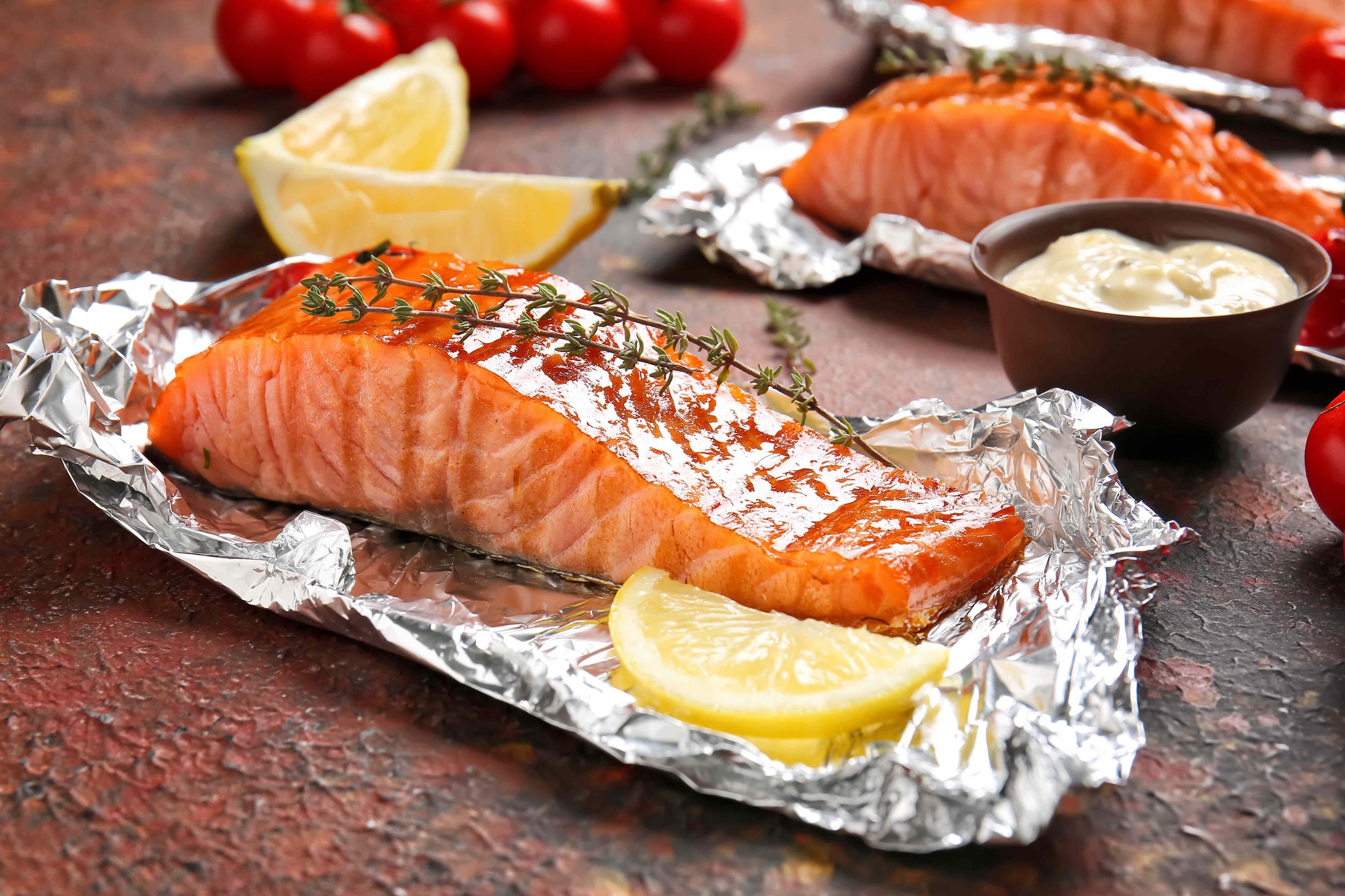Mastering Baking or Grilling Salmon in Foil
Hey there, friend! Today, we're diving into the wonderful world of salmon – that delectable, versatile, omega-3-rich fish that never fails to make a splash on our plates. I say salmon is versatile because it's like a blank canvas, ready to soak up all the flavors you throw its way. I’ve added ideas with everything from Spicy Salmon dishes to Sweet and Citrsy combinations below!
Whether you're a seasoned chef or a kitchen rookie, fear not! We're about to go on a foil salmon-cooking adventure that will have you cooking like a pro in no time! And the good news is it’s perfect for a Weeknight Rescue Meal or a Get-Together with Friends!
You can roast, bake, saute or even Sous Vide salmon. But today, we are talking FOIL! Salmon Foil Grill vs. Salmon Foil Bake:
Let's start with the basics of salmon in foil: the Salmon Foil Grill and the Salmon Foil Bake. The deciding factor is whether you want to be inside or out by the grill. Grilling is great when you have friends over and can relax and enjoy the outdoors, but the oven is perfect for a quick weeknight rescue meal. I’ll talk about what seasonings and sides go well with salmon, too!
Salmon Foil Grill:
Cue the sizzle and gather 'round because the Salmon Foil Grill party is all about bringing the party outdoors. Imagine a relaxing evening, the grill fired up, and the and letting the grill do the work.
Ingredients:
4 salmon fillets
2 tablespoons olive oil
1 teaspoon garlic powder
1 teaspoon onion powder
Salt and pepper to taste
Fresh lemon slices for garnish
Chopped fresh parsley for a pop of color (optional)
Instructions:
Preheat the Grill: Fire up your grill to medium-high heat. While it's heating, lay out four sheets of heavy-duty aluminum foil, ensuring they're large enough to wrap each salmon fillet.
Prepare the Salmon: Place each salmon fillet on an individual piece of foil. Drizzle them with olive oil, ensuring a nice, even coating. This step not only adds a touch of richness but also helps prevent sticking. PRO TIP: fold the thin piece of the salmon under so it’s not overcooked. See my video below:
Season to Perfection: Sprinkle garlic powder, onion powder, a generous sprinkle salt, and pepper evenly over each fillet. Don't be shy with the seasoning; it's the key to unlocking the full flavor potential of the salmon.
Wrap it Up: Carefully fold and seal each foil packet, creating a snug cocoon for your seasoned salmon. This method not only enhances the flavors but also makes cleanup a breeze – no grill scrubbing required!
Grill to Juicy Perfection: Place the foil-wrapped salmon directly on the grill grates. Grill for about 12-15 minutes, or until the salmon easily flakes with a fork. The foil locks in the moisture, ensuring each bite is succulent and bursting with flavor. How Long To Grill Salmon in Foil:
The FDA considers Salmon fully cooked when it reaches 145 degrees Fahrenheit but I like mine cooked to 135 degrees. Generally, salmon on the grill in foil takes about 10 to 15 minutes to cook. The best way to ensure your salmon is fully cooked is by using a meat thermometer. Insert the thermometer in the center of the thickest part of the salmon to get an accurate read.
Serve with a Zesty Twist: Unwrap the foil packets with caution (steam alert!), and transfer the salmon to serving plates. Garnish with fresh lemon slices for a zesty kick, and sprinkle chopped fresh parsley for a burst of color (if desired).
Enjoy! Dive into your foil-grilled salmon creation.
salmon foil bake
Salmon Foil Bake:
2 pound side of salmon boneless (skin on or off, depending upon your preference), wild caught if possible. Or salmon filets placed side by side in foil.
2 small lemons. one sliced the other halved.
3 tablespoons olive oil
1 teaspoon kosher salt
1/4 teaspoon, pepper if desired.
4 cloves garlic peeled and roughly chopped
Additional chopped fresh herbs such as basil, thyme, parsley, dill, or green onion (optional)
Instructions
Heat oven to 375 degrees F. Line a large baking dish or rimmed baking sheet with a large piece of aluminum foil.
Lightly coat the foil with olive oil and add 1/2 the slices of the lemons down the middle and place the salmon on top. Tuck the thin pieces under a bit so they are not overcooked.
Drizzle the salmon with the olive oil and sprinkle with the salt and pepper. Rub to coat, then scatter the garlic cloves over the top. Lay the remaining lemon slices on top of the salmon. Juice the second lemon, then pour the juice over the top.
Fold the sides of the aluminum foil up and over the top of the salmon until it is completely enclosed. Place a second piece on top and fold the edges under if your foil isn’t large enough. You want it to be a sealed packet.
Bake the salmon for 15-20 minutes until the salmon is almost completely cooked through at the thickest part. (It’s best to use a thermometer and see the salmon cooking temperatures below) The cooking time will vary based on the thickness of your salmon. If your side is thinner (around 1-inch thick), check several minutes early to ensure your salmon does not overcook. If your piece is very thick (1 1/2 inches or more), it may need longer.
Remove the salmon from the oven and carefully open the foil so that the top of the fish is completely uncovered (be careful of hot steam). Change the oven setting to broil, then return the fish to the oven and broil for 1-2 minutes, until the top of the salmon and the garlic are slightly golden and the fish is cooked through. Watch the salmon closely as it broils to make sure it doesn’t overcook and the garlic does not burn. Remove the salmon from the oven. If it still appears a bit underdone, you can wrap the foil back over the top and let it rest for a few minutes. Do not let it sit too long—salmon can go from “not done” to “overdone” very quickly. Your best bet is to use a thermometer.
To serve, cut the salmon into portions. Sprinkle with an extra squeeze of lemon as desired.
SALMON TEMPERATURES
Another way to think about salmon temperature is by rare, medium-rare, medium, and well-done. My preference is medium/medium-rare.
Remove the salmon from the heat at each below the temperature range because it will continue to cook even off the heat. Open the salmon pack so it slows the cooking down. Once you have your perfect temp, write that temp and approximate time down that’s your go-to!
Rare Salmon. Less than 120 degrees F.
Medium-Rare Salmon. 125 degrees F to 130 degrees F.
Medium Salmon. 135 degrees F to 140 degrees F (the sweet spot!).
Well-Done Salmon. 145 degrees F or more (not great)
From Sweet to Spicy Salmon Dishes
Classic Citrus Zest:
Fresh lemon or lime zest adds a zing that complements salmon's natural richness.
Herby Dill:
Dill provides a fresh, aromatic note, enhancing the overall flavor profile. Add chopped or mixed with sour cream or mayo. ummm.
Garlic Goodness:
A touch of garlic powder or minced garlic elevates salmon flavors.
Smoky Paprika:
Smoked or regular paprika imparts a smoky depth, perfect for adding a hint of complexity.
Peppery Black Pepper:
Freshly ground black pepper adds a warm, peppery kick that complements the salmon's richness.
Kosher Salt Simplicity:
Simple sea salt highlights the salmon's natural flavors without overpowering. Or mix with lemon zest.
Soy Sauce Elegance:
A drizzle of soy sauce brings a savory umami element, creating a perfect balance.
Maple Syrup Sweetness:
A touch of maple syrup adds a subtle sweetness, creating a harmonious contrast.
Spicy Salmon Dishes:
For those who crave heat, simple crushed red pepper flakes provide a fiery kick to your salmon.
Or for a more complex flavor, combine:
1 tablespoon brown sugar optional; omit for Paleo or Whole30
1 1/2 teaspoons chipotle chile powder
1 medium lime zest and 1 tablespoon juice
1 tablespoon brown sugar optional;
salt and pepper
Storage Tips
To Store. Refrigerate salmon in an airtight container for up to 2 days.
To Reheat. Very gently rewarm leftovers in a baking dish in the oven at 350 degrees F or in the microwave.
To Freeze. Freeze salmon in an airtight, freezer-safe storage container for up to 3 months.



